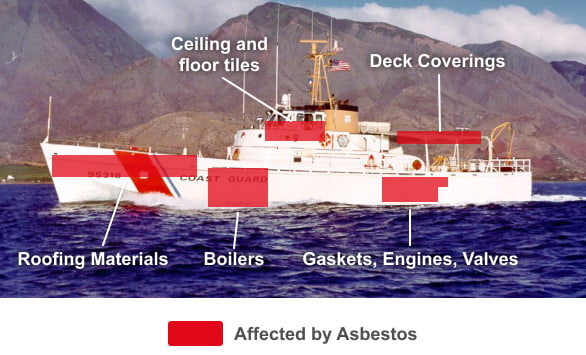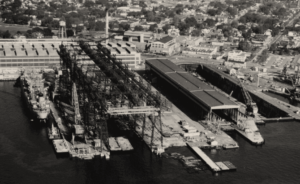United States Coast Guard cutters relied on asbestos — a cancer-causing material — until the early 1990s. Coast Guard veterans that were exposed to asbestos on cutters have a high chance of developing mesothelioma, a deadly cancer with no cure. Thankfully, veterans with asbestos-related diseases stemming from military service can pursue military benefits and compensation. Don’t wait: see if you could take action today.
Did Coast Guard Cutters Use Asbestos?
Yes, virtually every U.S. Coast Guard cutter in service between the 1930s and early 1990s contained asbestos products.
Products used on cutters that contained asbestos included:
- Boilers
- Deck covering
- Electric wires
- Floor tiles
- Gaskets
- Insulation
- Valves

Asbestos was considered an important material to keep those on Coast Guard vessels safe, as it was an excellent insulator and fireproofing agent.
However, asbestos can cause many life-threatening health problems, including cancers like mesothelioma 10-50 years after exposure.
The U.S. military did not realize that Coast Guard personnel exposed to asbestos were being put at risk of mesothelioma. This is because manufacturers of asbestos-based products hid the health dangers for decades.
By the time the risks of asbestos on cutters came to light, hundreds of thousands of Coast Guard personnel had already been exposed.
Help is available for U.S. Coast Guard veterans with mesothelioma that stems from asbestos on cutters. By working with the Mesothelioma Veterans Center, veterans can get benefits from the U.S. Department of Veterans Affairs (VA), find top doctors, and pursue compensation from the makers of asbestos-based products.
See all the ways we assist veterans like you in our Free Veterans Packet.
List of Coast Guard Cutters With Asbestos
Almost every cutter built between the 1930s and 1991 likely contained asbestos. This accounts for over 300 cutters.
U.S. Coast Guard Cutters that used asbestos included:
- USCGC Absecon (WHEC-374)
- USCGC Active (WMEC-618)
- USCGC Acushnet (WMEC-167)
- USCGC Alert (WMEC-630)
- USCGC Androscoggin (WHEC-68)
- USCGC Barataria (WHEC-381)
- USCGC Bering Strait (WHEC-382)
- USCGC Bibb (WPG-31)
- USCGC Boutwell (WHEC-719)
- USCGC Campbell (WPG-32)
- USCGC Casco (WHEC-370)
- USCGC Castle Rock (WHEC-383)
- USCGC Chase (WHEC-718)
- USCGC Chautauqua (WHEC-41)
- USCGC Chincoteague (WHEC-375)
- USCGC Confidence (WMEC-619)
- USCGC Cook Inlet (WHEC-384)
- USCGC Coos Bay (WHEC-376)
- USCGC Courageous (WMEC-622)
- USCGC Dallas (WHEC-716)
- USCGC Dauntless (WMEC-624)
- USCGC Decisive (WMEC-629)
- USCGC Dependable (WMEC-626)
- USCGC Dexter (WHEC-385)
- USCGC Diligence (WMEC-616)
- USCGC Duane (WPG-33)
- USCGC Durable (WMEC-628)
- USCGC Escanaba (WHEC-64)
- USCGC Escape (WMEC-6)
- USCGC Gallatin (WHEC-721)
- USCGC Gresham (WHEC-387)
- USCGC Haida (WPG-45)
- USCGC Half Moon (WHEC-378)
- USCGC Hamilton (WHEC-715)
- USCGC Hamilton (WPG-34)
- USCGC Humboldt (WHEC-372)
- USCGC Ingham (WPG-35)
- USCGC Iroquois (WHEC-43)
- USCGC Jarvis (WHEC-725)
- USCGC Klamath (WHEC-66)
- USCGC Mackinac (WHEC-373)
- USCGC Matagorda (WHEC-371)
- USCGC McCulloch (WHEC-386)
- USCGC Mellon (WHEC-717)
- USCGC Mendota (WHEC-69)
- USCGC Midgett (WHEC-726)
- USCGC Minnetonka (WHEC-67)
- USCGC Modoc (WPG-46)
- USCGC Mojave (WPG-47)
- USCGC Morgenthau (WHEC-70)
- USCGC Munro (WHEC-724)
- USCGC Owasco (WHEC-39)
- USCGC Pontchartrain (WHEC-70)
- USCGC Reliance (WMEC-615)
- USCGC Resolute (WMEC-620)
- USCGC Rockaway (WHEC-377)
- USCGC Rush (WHEC-723)
- USCGC Sebago (WHEC-42)
- USCGC Sherman (WHEC-720)
- USCGC Spencer (WPG-36)
- USCGC Steadfast (WMEC-623)
- USCGC Tampa (WPG-48)
- USCGC Taney (WPG-37)
- USCGC Unimak (WHEC-379)
- USCGC Valiant (WMEC-621)
- USCGC Venturous (WMEC-625)
- USCGC Vigilant (WMEC-617)
- USCGC Vigorous (WMEC-627)
- USCGC Winona (WHEC-65)
- USCGC Yakutat (WHEC-380)
- USCGC Yocona (ex-Seize) (WMEC-168)
The list shown above is only a partial one, so you may have been exposed even if you don’t see a cutter that you served on.
Further, every U.S. Navy ship was built with asbestos between the 1930s and early 1980s. If you served on any of these ships, you could be at risk of mesothelioma today.
Risks of Asbestos on Coast Guard Cutters
Nearly all Coast Guard cutters built before 1991 used asbestos products, putting those who served at risk of serious cancers like mesothelioma.
These products could have released fibers into the air when they were damaged, disturbed, or repaired.
“Routine exposure for asbestos and lead would include working on and berthing in a Coast Guard cutter where there may be small exposed areas of asbestos-containing thermal insulation, a number of torn asbestos-containing floor tiles, and lead dust from lead ballast ingots and lead-containing paint.”
— United States Coast Guard official website
Coast Guard personnel working with or around asbestos on cutters could inhale the fibers, which would get trapped in the body and irritate healthy cells and tissues.
Who Was At Risk of Asbestos on Cutters?
Anyone who served on U.S. Coast Guard cutters constructed prior to 1991 could have been exposed to asbestos.
Coast Guard members who worked directly with asbestos-containing products had the greatest risk of exposure.


- Boilermen
- Electricians
- Engine room workers
- Insulation workers
- Pipefitters
- Plumbers
Coast Guard shipyard workers also had an increased risk of asbestos exposure. Those working in shipyards had to remove damaged asbestos products and install new ones, which often sent fibers flying into the air where they could be breathed in.
A report found that those who worked in the Curtis Bay Coast Guard Yard between 1950 and 1964 had an increased risk of lung cancer and mesothelioma, “most of which is probably related to asbestos exposure.”
Get a Free Veterans Packet to learn if your time in the Coast Guard possibly caused you to develop mesothelioma later in life.
How Was Asbestos Used on Coast Guard Cutters?
Some of the most common asbestos-containing products used on cutters were gaskets, wiring, valves, pipe fitting, tiles, insulation, flooring tiles, and deck covering material.
Certain areas of these ships used asbestos-based products in high concentrations.
Asbestos-based products were often found in:
- Berthing spaces: Asbestos was used in flooring material and ceiling tiles in berthing spaces. Even the walls were likely insulated with asbestos.
- Engine and boiler rooms: Engines and boilers get very hot. Asbestos gaskets and insulation were used to prevent fires in these rooms.
- Pump rooms: Valves and gaskets in pump rooms typically contained asbestos. Even the pipes themselves were often made with this deadly material.
The risk of asbestos exposure was very high aboard cutters — especially below deck. Like many other Coast Guard and Navy ships, cutters often had poor ventilation.
This meant asbestos fibers could linger in the air for long periods, putting anyone nearby at risk of inahling the fibers.
Call (877) 450-8973 now to pursue VA benefits and compensation if you have mesothelioma after serving on a Coast Guard cutter.
Compensation for Coast Guard Veterans With Mesothelioma
No military veteran ever deserves to suffer from a deadly cancer like mesothelioma simply for serving their country.
Coast Guard veterans who developed mesothelioma after exposure to asbestos on cutters may be able to access compensation to cover medical expenses and other costs. Learn about mesothelioma compensation options below.
VA Benefits
Coast Guard veterans may qualify for financial and medical VA benefits if they were exposed to asbestos during active duty and now have mesothelioma.
Mesothelioma is considered to be a 100% disability by the VA, so veterans can get the highest disability payouts possible — almost $4,000 a month for married veterans as of 2024.
Other benefits include free or low-cost medical care, pensions, and survivor benefits.
We can help you file a VA claim or increase your disability rating to 100% if you already have them. Get started now.
Mesothelioma Lawsuits
Mesothelioma lawsuits award veterans an average of $1 million, which can help cover expenses and keep families financially secure.
These lawsuits are filed against companies that made and sold asbestos products. These companies discovered the dangers of asbestos in the 1930s but hid this information to keep making money. The Coast Guard and other military branches are never sued.
Our team recently secured $1.27 million for a Navy veteran from Florida who developed peritoneal mesothelioma. He had been exposed to asbestos as an electronics technician aboard the USCGC Escape.
Filing a mesothelioma lawsuit won’t impact your current or future VA benefits. In fact, we can help you file mesothelioma lawsuits and VA benefits claims at the same time if you qualify.
Asbestos Trust Fund Claims
Many manufacturers of asbestos-based products declared bankruptcy to avoid lawsuits. In return, they were forced to establish asbestos trust funds to pay those who were harmed.
Over $30 billion is available in trusts today, and Coast Guard veterans may be entitled to some of this money. We can file claims on your behalf with any asbestos trust funds you qualify for.
Get Help After Serving on Coast Guard Cutters With Asbestos
Coast Guard veterans didn't realize that asbestos on cutters could put them at risk of cancers like mesothelioma.
If you’ve been diagnosed with mesothelioma, you don’t have to fight alone. The Mesothelioma Veterans Center team — including caring patient advocates, fellow veterans, and VA-accredited attorneys — is here to help.
Work with our team to access:
- VA benefits
- Legal compensation from lawsuits and trust funds
- Medical care from top cancer doctors and hospitals
- A sense of justice and closure
Get a Free Veterans Packet to see all the ways our team can help you.
Asbestos on Cutters FAQs
What products contain asbestos on cutters?
Cutters and other military ships were built with asbestos-containing products like insulation, piping, floor and ceiling tiles, and gaskets to keep them durable and fireproof.
If these materials were disturbed, they could release asbestos fibers into the air. This put Coast Guard personnel nearby at risk of asbestos-related illnesses like mesothelioma.
If you may have been exposed to asbestos on cutters and later developed mesothelioma, we may be able to assist you. Call (877) 450-8973 now to get help accessing VA benefits, financial compensation, and medical care.
Which U.S. Navy ships had asbestos?
Over 300 Coast Guard cutters and almost all other military ships contained asbestos-based products between the 1930s and early 1980s.
During this time, U.S. military personnel had no idea that asbestos could lead to cancers like mesothelioma since the risks were hidden by private companies.
While major renovation efforts began to remove asbestos from Navy ships in the 1980s, Coast Guard cutters built through 1991 may have contained asbestos.
Are military service members still at risk of asbestos on cutters?
Possibly, yes. Older cutters and Navy ships underwent major renovation efforts to remove asbestos-based products and lower the risks. But, some cutters still contain asbestos even today as it wasn’t possible to remove all of it.
Paul F. Zukunft, former Commandant of the Coast Guard, expressed the need for new and safer cutters in 2017. He said that many older cutters were being monitored due to the risks of asbestos and lead onboard.
What are the first signs of asbestos exposure?
First signs of asbestos diseases like mesothelioma include a cough, shortness of breath, and pain. These symptoms typically appear 10-50 years after exposure.
If you or a loved one may have been exposed to asbestos on cutters decades ago and is now experiencing mesothelioma symptoms, see a doctor immediately.
Make sure to let them know about your asbestos exposure history, as this can help your doctor narrow down the possible causes of the symptoms.
What should you do if you are exposed to asbestos on cutters?
If you were exposed to asbestos on cutters decades ago, make sure to closely monitor your health as you get older.
Always promptly speak with your health care providers if you’re concerned about asbestos-related diseases like mesothelioma.
If you do get diagnosed with mesothelioma or another asbestos-related disease, connect with the Mesothelioma Veterans Center. We may be able to help you access treatments, financial compensation, and VA benefits.


